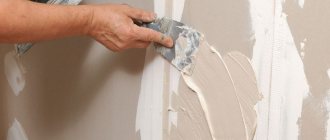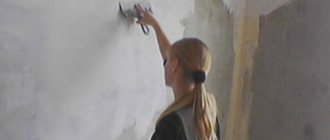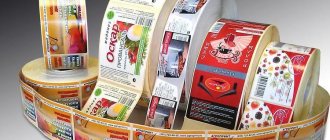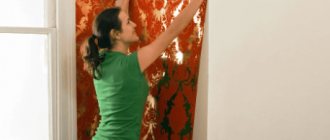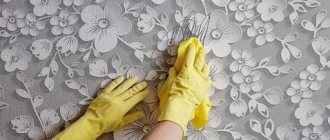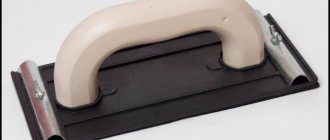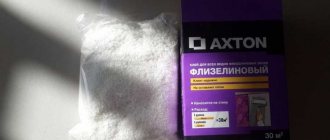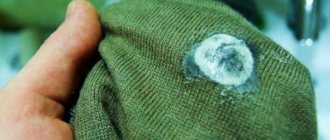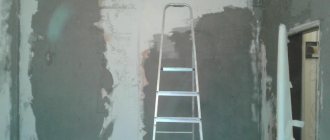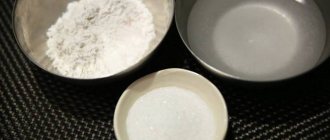Simple ways to remove glue from wallpaper after gluing
Glue stains left on wallpaper after renovation are not uncommon.
At first they may be almost invisible, but over time, due to settled dust, the marks will take on a dirty yellow tint. To prevent this from happening, you need to know how to remove glue from wallpaper after gluing. Read the article about which home and professional remedies and formulations are best to use.
How to remove wallpaper adhesive after renovation?
You can remove the glue with warm water. If the composition has already dried, use more aggressive solvents, for example, vodka or vinegar.
Warm water
Fresh stains can be easily removed with warm water. Procedure:
- Wet a clean sponge and squeeze it well.
- Rub the sticky stain 2-3 times.
- Rinse the sponge in warm water and walk over the surface to consolidate the result.
You should not rub the wall covering too hard to avoid damaging it. If the non-woven material is not too sensitive to moisture, then paper wallpaper should be handled with care.
How to remove dried residue with vinegar?
If the glue has dried, table vinegar will help to deal with it. Use it as follows:
- apply a small amount of vinegar to a cotton pad;
- moisten the stain with it and leave for 2-3 minutes;
- walk over the problem area again to thoroughly clean it.
Vodka
The alcohol contained in vodka allows you to dissolve dried glue and remove the stain without a trace. Procedure:
- Apply vodka to a clean cloth.
- Treat the stain and leave for 2-3 minutes.
- Remove the softened compound from the wall surface with a light movement.
It is not recommended to use alcohol in its pure form; its concentration is too high, which can cause damage to the wallpaper.
Professional products
If the wallpaper is expensive, then it is better to use professional removers to remove the glue. These include:
- H.G. This all-purpose cleaner is suitable for removing glue from wallpaper, painted walls and plastic. With its help, you can remove even dried stains in a few minutes. The cost of a 500 ml spray is 330 rubles.
- Prosept Duty Scotch . It contains solvents that allow you to quickly get rid of wallpaper glue. Simply spray the product onto the stain and wipe it with a paper towel. The cost of a 400 ml bottle is 350 rubles.
- Mellerud. A universal adhesive remover that can be used to clean wallpaper. The cost of a 250 ml bottle is 440 rubles.
Ambulance
As with any (absolutely any!) stain, the principle applies here - the faster, the better. Fresh stains can be removed easily and with less impact on the wallpaper. Therefore, already in the process of pasting the walls, watch where droplets of glue come out of the joints. Blot them gently, try not to smear. The darker and more textured the wallpaper, the more visible glue marks are.
As soon as you see traces of glue on the wallpaper you just pasted, arm yourself with a soft cloth slightly moistened with water. Blot the marks with gentle movements, and then use a clean napkin without pressing along the joint line. Try not to move the wallpaper - until the glue has dried, they are movable.
If the glue has dried, you can try soaking it. To do this, spray the stain a couple of times with a spray bottle. Let the water soak in, and after 10 minutes, wipe the area with a dry cloth. The task is to dissolve the starch, which is the basis of any wallpaper glue. If water does not help, use a weak solution of vinegar (after testing the composition on the rest of the wallpaper!).
All these methods are good for thick wallpaper on non-woven or other modern bases. Thin paper ones, especially if their surface is uncoated, will be more difficult to clean.
How to prevent stains?
To avoid having to deal with the problem of stains on wallpaper in the future, you need to follow simple recommendations:
Don't skimp on buying brushes. To apply the glue evenly and accurately, you need to choose a tool with natural bristles.- If excess glue appears, it must be removed immediately with a clean, damp cloth.
- You should not apply too much glue to the wallpaper strip so that it does not protrude beyond its borders.
- For a better fit of the material to the wall, you need to go over it with a roller. For this purpose, use only clean tools.
How to remove wallpaper glue
It's time to replace the wallpaper.
After removing them from the walls, it is necessary to remove the remaining glue. This is the only way to get a clean surface that will be good for applying new wallpaper. Before starting work, it is worth protecting the floor. A plastic film that can be used to cover the floor covering is suitable for this. It is advisable to prepare rags and towels that will be needed for work in advance. The next step is to prepare the solution. To do this, you need to pour water into a bowl, as hot as possible, into which add a spoonful of dishwashing detergent (any kind). This composition will help dissolve the glue remaining on the wall after removing the used wallpaper. It is recommended, for the most effective results, to replace cold water with hot water.
Using a sponge, which is constantly dipped into the prepared hot solution, wash small areas of the surface to soften the hardened glue. In areas where there is a larger accumulation of glue, it is recommended to use a brush with which to wipe more intensively. After removing any remaining adhesive, the wall should be washed with fresh water. To do this, use wet rags or towels to remove any residues of both glue and detergent. The operation should be carried out several times until the walls are completely clean. The last task is to sand the dry wall to obtain a perfectly smooth surface.
Walls can be cleaned of wallpaper paste residues using other mixtures. For example, using warm water and vinegar. A bucket of hot water requires a cup of vinegar. Apply the resulting composition to the wall and leave for 10 minutes. Continue using a scraper and sponge to scrape off the soft glue from the wall. It is imperative to wash the wall, as in the first case. Another cleaning solution you can make at home is hot water with baking soda and fabric softener. Amount: per bucket of water (hot), a tablespoon of bicarbonate and 4 tablespoons of conditioner. Knowledgeable people recommend another method: using aluminum foil. It is applied to the area to be treated and heated with an iron. The remaining wallpaper glue heats up and can be easily removed with a scraper. The advantage of this method is the absence of water, which means there is no need to wait until the walls dry.
Special Moments
Removing tiles is a monotonous process that requires concentration and accuracy. Tile is a fairly fragile material, it is easy to split or scratch, so all manipulations are carried out with care.
- When removing the adhesive mass dryly, a large amount of dust is generated, from which you need to protect your eyes and respiratory organs.
- You can use a small putty knife or an old credit card to remove small stains on the tile surface.
- It is better to remove fresh glue stains immediately, without delaying until later. The rag used to wipe the tiles must be changed frequently, even if it is not completely dirty - frozen lumps can scratch the tiles with further use.
A craftsman of any level can remove tile adhesive from walls. Full understanding comes with the beginning of work in the effectiveness of which theoretical knowledge plays an important role.
Causes of stains on wallpaper
It is not always possible to avoid the appearance of all kinds of contaminants; this happens even among professionals; it depends on many factors:
- Insufficient preparation of the wall; the remnants of the previous application of glue were not removed during the previous wallpapering.
- Applying wallpaper to plasterboard walls should be done with complete putty.
- If the wall is covered with lime, then it must be puttied to avoid the reaction of the adhesive and lime, leaving faded spots.
Causes of stain formation
You have already learned how to remove glue from wallpaper, now it’s worth figuring out why they form. The formation of stains is due to the fact that the preparatory measures were carried out incorrectly. Before wallpapering, the wall must be thoroughly cleaned of old glue and old wallpaper.
Removing old wallpaper from the wall
If you glue the canvases to drywall, be sure to apply putty to it. Puttying must be done on a surface that has lime stains. When interacting with the wallpaper composition, it will begin to appear in the form of yellow spots. It will definitely not be possible to remove such a defect.
If the wall surface is perfectly clean, treated with an antifungal compound and puttied, then wallpaper can be applied to it.
You should not glue the canvases when the wall is not dry. As a result, stains may form, the cause of which lies in the adhesive solution of poor quality.
Often stains are formed due to the reaction of the old glue with the primer and the new composition. To eliminate this process, it is necessary to carefully remove the old coating from the wall surface.
If you use a high-quality composition when working, but apply it in large quantities, and have not yet removed the excess in time, then you cannot avoid the formation of stains.
It’s a pleasure to hang wallpaper on a well-prepared wall.
When gluing non-woven fabrics, you should not apply glue to them. You should only treat the wall with the compound. This will be enough to ensure that the canvases are very firmly attached to the wall. Excess glue should be removed with a wet, clean cloth or soft towel.
Excess glue begins to come out from under the wallpaper due to its excess. Sometimes you have to use a lot of glue to glue the canvas. The reason is that during the dilution of the composition the preparation technology was violated. Therefore, when diluting glue, strictly adhere to the instructions, which state that the water used should be at room temperature.
When applying glue to wallpaper, it is good to use a brush
To apply the composition, you must use a wide brush with natural bristles.
If the solution is distributed evenly, you do not need to apply it in excess.
Is it possible not to remove the adhesive mixture from the walls?
As a rule, any facing work begins with preparing the working surface and removing the old layer of adhesive mixture. An exception may be when dismantling the floor, when the tiles come off without effort, and the hardened mixture is a monolith without serious irregularities or cracks.
In this case, carefully seal the cracks, dents and voids that remain from the previous masonry. You can do the same when removing tiles from the wall, if you are sure that the walls were initially well prepared. Otherwise, the glue must be removed without fail.
Options for withdrawal
The main difficulty is removing the hardened adhesive mass. Depending on the strength of the composition and the age of installation, the following cleaning methods are used.
- Dry. The adhesive mixture is removed from the surface using a hammer and chisel or a hammer drill with a wide blade. The hammer drill should be held at an angle - this will make the process easier and faster. Residues are cleaned with sandpaper or a brush (manual or rotary).
- Wet . Tile adhesive is moistened generously with water using a spray bottle or a wide brush, which greatly facilitates dismantling work. After the moisture is completely absorbed into the hardened glue, it is removed mechanically.
How to remove old glue
The use of chemicals has proven successful in removing old glue. The method is used on surfaces for which intensive exposure is contraindicated. For these purposes, acid-containing substances (vinegar, citric acid), soda, and lime are used. Also, regular Cola has proven itself to be a good solvent for tile adhesive.
Before removing the old adhesive, you need to buy a tile adhesive solvent. It is applied to the stains, left for 10-15 minutes to achieve a chemical reaction, then the residue is removed with a rag.
How to remove fresh adhesive from glossy tiles?
Often, stains remain on the tiles during the work process. Fresh adhesive from glossy tiles can be easily removed with a cloth soaked in warm water.
It is convenient to use a sponge for washing dishes - with the hard side you can clean up dry areas.
The remaining stains are wiped off with a rag or thick cloth.
How to avoid stains
In order not to damage the walls when gluing and to avoid the appearance of stains, you should follow simple recommendations:
- coating of canvases should be carried out in an even layer, without excessive excess;
- It is important to wipe the area where the glue is applied with a damp sponge after processing each sheet to avoid contamination;
- Having glued the canvas and carefully straightened it, wipe off the exposed glue;
- For strong setting, the room must be at room temperature, without drafts.
By listening to simple tips, it is easy to avoid unpleasant surprises and make the repair process high-quality and enjoyable.
Safety regulations
During processing, you should prepare solutions, tools and other accessories in advance, as well as provide personal protection:
- to avoid poisoning by harmful fumes, you need to open the windows in the room or arrange other ventilation;
- it is necessary to wear rubber gloves to avoid unwanted exposure to chemicals on the skin of the hands;
- prevent harmful vapors from entering the respiratory tract by wearing a medical mask or respirator;
- put on a hat.
Since chemicals can cause an allergic reaction, people prone to such reactions are better off using mechanical methods to remove dirt from ceramics or using previously proven products that do not cause allergies.
Wash the wallpaper
Important! It is better to deal with any stains on the wallpaper immediately after they appear. In this case, there is a high probability of their instant removal. Wallpaper glue is a simple product, but prompt action will be beneficial. To prevent stains from appearing on the surface of the wallpaper, use the following preventive measures:
- Lubricate the fabric with adhesive without excess so that it does not bleed through the seams;
- The work surface on which you lay out the canvas must be clean;
- After you have applied the coating, treat it with a clean cloth, and then go over it with a roller. If the glue still bleeds through, blot it again with a rag.
Remove old, dried construction material from walls
Before you start gluing new wallpaper, you need to clean the walls of old, hardened PVA glue. Removing dried adhesive from the surface of walls is a labor-intensive task. Special solvents of natural and synthetic origin will help get rid of it:
- Try washing off the adhesive. Wet the problem area with a spray bottle, wait a while, then start scrubbing with a clean cloth. Repeat the procedure if necessary;
- When choosing a dry cleaning type, use only brushes and sponges. The task is to act abrasively on the surface of the wall. Clean off any stuck adhesive. Be careful!
- Dried glue is much more difficult to remove than fresh glue. Take a rag and soak it in soapy water. Treat the problem area and wait a few minutes. Then try scraping off the glue with a spatula. If it is difficult to remove, then moisten the problem area again;
- You can try removing old glue stains with steam under pressure. Use a special pump for this;
- In some cases, you can use a vinegar solution to remove dried glue;
- Sandpaper will help get rid of dried glue on the wall. The method is very labor-intensive, since the dried mass can leave glaze on the wall. You will have to spend a lot of effort to sand off the glue.
This is interesting: How to cover or remove a dirty stain on liquid or paper wallpaper
Wash non-woven and vinyl after gluing
It is not difficult to wash non-woven wallpaper after gluing, which is facilitated by the water-repellent qualities of the material. After completing the procedure, the coating must be wiped with any cloth. Processing wall coverings requires compliance with the following rules:
- The drying time of the canvas will be commensurate with the treated area;
- The water-repellent properties of the material prevent moisture from penetrating deeper than the decorative layer;
- The canvas dries quickly, no more than an hour.
Features of removing stains on vinyl wallpaper
If the plaster has just recently got on the wallpaper, it can be easily removed before it has time to dry. A paper towel is moistened with clean water and the contaminated area is wiped in a circular motion. After 10–15 minutes, the wallpaper will dry and return to its original appearance.
You can remove dried plaster from vinyl wallpaper if the material is ready to withstand a little moisture and not deform:
- First, they pass over the dried compound with a scraper to loosen it a little.
- As soon as it begins to crumble, they begin to carefully remove it with their hands. The mixture at this moment will begin to easily move away from the surface of the wallpaper.
- Sticky pieces are carefully picked out with a spatula so as not to damage the structure of the wallpaper.
- Remaining oil stains are removed with isopropyl alcohol. Apply a cotton pad soaked in alcohol to the greasy stain for a few seconds. In just 2-3 minutes there will be no trace left on the wallpaper.
Do not oversaturate the wallpaper with too much moisture. Otherwise, the canvases will begin to peel off from the walls.
You can wipe off stains and wash off the remnants of the plaster layer in different ways, using ready-made and improvised means. Their choice depends on the material from which drops of plaster need to be removed.
Preparing the walls for finishing is an important stage in the renovation of a room. Only thorough cleaning of the entire surface of the walls from old wallpaper, paint, tiles, plaster or whitewash will subsequently allow for high-quality finishing work. And although this is a labor-intensive and messy process, it cannot be avoided. Regardless of which finishing option is chosen, the walls must be cleaned to the ground. The only exception is plasterboard sheathing.
How to hang wallpaper without leaving traces
When starting work without the help of professionals, be patient, adhere to the gluing technology, and promptly remove excess glue at the joints of the canvases.
Dried glue stains are much more difficult to clean; it is possible that the stains cannot be washed off.
When dealing with thin paper wallpaper, streak removal operations must be carried out carefully so as not to damage the surface of the canvas. The paper material is delicate, sudden movements will ruin all the work done. You can start after a small test from below, wipe the composition with a damp cloth.
To avoid problems, you should take a responsible approach to choosing glue. To do the job well, you need a special adhesive with the necessary properties and efficiency, do not spare money. Remember that apartment renovations take years to complete.
The special wallpaper composition of the adhesive substance, when dry, will save you from erasing and washing. The glue is invisible, so when buying a product, make sure it says what it says. The packaging must clearly state that the adhesive does not leave residue.
Removing dried glue
It is almost impossible to remove the glue that remains on the seams and has dried. But it is very shiny and stands out, especially on dark wallpaper. First, you need to understand whether the problem is that critical before taking action. It is also worth determining the surface of the canvas in advance, since its very delicate structure will allow you to remove the hated stain.
There are situations in which removing the glue is simply necessary. This:
Modern heavy wallpaper can be wet cleaned, the main thing is to always follow the instructions.
Wet cleaning of glue
Those fabrics that do not raise doubts about the possibility of wet processing can be moistened with warm water from a spray bottle. Wet areas should be left for 10 or 15 minutes, and then lightly wiped with a soft cloth. This method is ideal for dealing with starch-based glue that has not completely dried.
If a diluted starch-based adhesive was used, clear vinegar with a concentration of 9% can be used for cleaning. It reacts with starch and destroys its structure. As a result, the stain quickly disappears.
Another option for removing modified starch-based glue is this: the dried glue is covered with a paper napkin, and a small amount of window and mirror cleaner is sprayed on top. The mixture is kept for 15 minutes, after which the napkin is removed and the treated area is blotted with a dry paper towel. The wet area should dry on its own, never in a draft or under the influence of a hairdryer.
Important! PVA glue can be removed using warm water, to which you need to add vinegar or vodka.
Non-woven wallpaper can often be cleaned even with a brush; this is indicated on the packaging in the form of three waves and a brush. But first you need to try wiping them in an inconspicuous place with a damp sponge using a non-aggressive detergent. If you managed to remove the stain, but the canvas has not lost its previous appearance, then this cleaning can be applied to other stains.
Removal methods
If contamination occurs during operation, you will have to take measures to clean it. First, determine the type of wallpaper material.
Means for washing away contaminants:
- Detergents are not recommended for cleaning paper wallpaper, although the method is effective. Wipe off stains with a wet sponge, then wipe with dry cloths.
- Eraser sponge - when the pasted surface gets dirty with your hands, you often use an eraser. The eraser quickly removes the glue grooves, but remember that the pattern may be removed, try the method on an invisible area.
- Bread crumb - the method came from past centuries, it was used by our grandfathers and great-grandfathers. Now cleaning this way is no less effective. Application consists of pressing the crumb onto the resulting stain.
- A mixture of gasoline and tooth powder is a good method, but it cannot be used for all types of wall finishing materials. Using the mixture, it is easy to get rid of old dirt.
- Medical alcohol perfectly removes not only glue, but also children’s drawings with a felt-tip pen.
Removing glue from the front surface of wallpaper
For work you may need:
Tools for removing glue: rags, spray bottle, stain remover, marker, wallpaper remnants, decorative elements.
- damp rags;
- spray;
- special composition for removing stains;
- felt-tip pen or marker;
- wallpaper remnants;
- decorative elements (paintings, clocks, panels, etc.).
It happens that the glue gets on the decorative part of the panel, it shines and has a different color. This deficiency can be eliminated. But removing dried glue is more difficult than fresh glue. In the case when you have hung thick wallpaper, for example, vinyl, which can be washed, and the glue has dried, you need to moisten the sponge, lightly treat the canvas, and leave for a few minutes. The main thing is not to rub too intensely, do not spoil the drawing, do not rub to the hole
The thinner the wallpaper structure, the more care and caution is required. You can also carefully remove glue in this way from light non-woven wallpaper.
There are brands of wallpaper glue that, after some time of drying, become thin transparent films that can be removed without difficulty or leaving any traces. When the wallpaper paste is fresh, it is best to remove it with a damp sponge or rag, first removing the excess. When purchasing an adhesive composition, it is advisable to purchase a special product (ideally from the same manufacturer as the glue), which is designed to remove stains of various origins from the surface of the wallpaper, including those left by the glue.
When the glue remains on the dark non-woven panels, it is visible on the seams, the situation is hopeless, it will not be possible to remove the dried adhesive, the bleed-through compound is removed during the lining process. But light-colored seams can be disguised, painted over with a marker to match the color of the panels, after first checking this method on an area that is not visible to the eye. In the event that a stain remains or the appearance of the wallpaper is damaged, you can make a restoration using exactly the same roll or use decorative decorations.
By following simple rules for removing glue from the decorative part of wallpaper, gluing technology, being careful and diligent, and choosing the right adhesive, you can avoid problems associated with traces of glue.
The stains are not from wallpaper paste
Wallpaper can be damaged by the glue and not during the gluing process - PVA, Moment, gun glue, stationery glue, pencil and any other composition can get on it.
So, the first thing to do is try to wash the stain as quickly as possible. If the adhesive composition is liquid, a solution of dishwashing detergent will do. As long as the glue has not dried, it will come off easily, and the detergent composition will protect it from leaving a mark.
If the glue has dried, it must first be removed dry. A suitable option is an eraser or bread crumb. Take an eraser with two ends - rough and soft. First, gently rub the stain with the rough end of the eraser, and then with the regular end. Do not make sudden movements, otherwise you may erase the design from the wallpaper. A rough eraser can remove fairly large traces of glue, with a frozen drop, for example.
You can try making a paste from baking soda or tooth powder. Apply it to a napkin or an old toothbrush and rub the stain.
Some types of glue can be removed from wallpaper using ethyl alcohol or gasoline. All these methods are suitable for thick wallpaper on a non-paper basis (vinyl, non-woven fabric, etc.). Be sure to try the product on an inconspicuous area - in a corner, behind a sofa, etc. If you are a rare owner of simple paper wallpaper, then it is better to think about how to decorate the stain, because it is unlikely to be removed. Consider interior vinyl decals.
